If your commission enquiries and sales are sometimes a little thin on the ground, I can tell you I’ve been there! You can take measures to address this. Let me show you what I’ve learned about that dubious phrase “getting your name out there” over the last few years.
I see quite a lot of advertisement in one form or another, and sometimes have difficulty figuring out what the message is, or what’s in it for the target audience. I’m quite skeptical by default, and I’m usually quite happy just sitting down and being a person, without outside influences. If I ever need something, I tend to look for it myself, and if I get a whiff of brazen profiteering, I’m put off immediately.
A huge marketing budget may allow within it a campaign that doesn’t immediately appear to cater to a specific need, but if a small business I’ve never heard of tries the same, it doesn’t stand a chance getting through to me. Without thought, and with indiscrinimate spending, adverts are just noise. We all have an acceptable amount of that in life without looking for more.
The right starting point
Need a new piece of sports clothing? Adidas or Nike will probably cross your mind before buying. If we’re in the mood for a soft drink, we’ll probably recall Coca Cola before anything else. That’s the desired result of an awful lot of advertising grunt work, done year after year, shown everywhere across countless channels – TV, magazines, radio, newspapers, billboards, social media and YouTube, with a hefty marketing budget to match.
The aim of this kind of marketing is to be perennially visible and dependable, and keep as many people as possible “warm” to your brand while they’re not even looking for you. Such marketplace behemoths have single-handedly spent in the billions per year consolidating their position as an outfit worthy of your trust, a reliable option and a household name, by flooding your consciousness with their message. As soon as a need or desire presents itself, it’s likely you’re already predisposed to favour one of these brands.
Start-up businesses should not invest in communicating their brand image across a broad domain, or try to stay “top-of-mind” like this. It takes a lot of money and effort you can’t afford in the early stages, and if you have a marketing plan that vaguely circles this idea, chances are it won’t last. You’re just not set up for it.
Think about what Adidas has achieved with all this effort; brand recognition, loyalty, trust. The great thing is, there’s a way for you to achieve this on your more manageable scale too, but you have to go about it a different way. Introducing “direct response” marketing. This is where you induce direct responses through a publicised message or offer.
The nuts and bolts
“Why do I need to think about presenting an “offer”? Is the service I dispense not enough? I’m already just getting by without reducing prices!”
There’s no need to reduce your prices. However, a unique message and offer of some kind could be essential. Don’t forget, people are busy, tired and bombarded. Your advert will blend in with thousands of others if you’re not careful, especially if you’re putting it out there into a worldwide online marketplace.
Think about your strengths. What is it about your product, experience, location or extra skills that you can use to your advantage, and would result in very little extra legwork for you, but mean the world to your audience?
Your message/offer should be risk-free, with no tie-ins, and offer genuine value.
Time to get specific. My offer is a free photo session for locals, with a few of the best photos sent afterwards by email, or free photography advice for anyone at all who asks.

The “locals photo session” thing really suits me, as I like to build my business locally first, and meet potential clients, rather than do every single thing online. The world’s…huge, obviously, and the internet can access the majority of it, but it still can’t replace face-to-face contact, human interaction, all that old-fashioned stuff that good relationships are built upon.
I know just enough about photography to take some decent photos, and to inform clients who are interested in photography, in a relatable way. That’s my initial offer. To the hobbyist “snapper” who isn’t au fait with certain techniques or appropriate camera settings, this can be quite valuable.
To top it off: if the person I meet takes me up on my commission service, conveniently, I normally prefer to work from my own photos than from most smartphone pics. I know what I’m looking for in an image, and I have a bunch already to choose from, so this fits me really well. Use this idea yourself! As much as I had the lightbulb moment, I don’t own it 🙂
If your potential client hasn’t already shown interest in the paid service that relates to the value you’ve provided, you can nudge them gently towards it, and offer a special discount, just for being local, or for letting you use a photo. I stress that discounts shouldn’t be your starting point as you cast the net wide, as you may only attract those who value your service as a negotiable commodity.
Those who are keen may ask more. Those who aren’t may ask in a year. Some may never see you again. In any case, if they’re saying “no” right now, just give them a smile, your contact details, and assure them you’re always around if they ever want to know more about you.
That’s where you leave it. Respect people’s boundaries, and don’t be pushy.
You got to meet someone, impart some knowledge while keeping the wheels greased with your photography skills (or whatever you’re offering), and give some genuine value at no personal expense. In and of itself, I walk away from this kind of exchange very happy. It feels good to give!
So, how do you publicise your initial offer?
Whichever channel you choose, make it a single, clear message, clutter-free and with no extra fat on it. Whatever mode of contact you prefer might not be the same for others, so make it as easy as possible to get in touch, offering your website, email, phone number social media details.
And don’t blow your whole advertising investment in one go. Responses are much more likely collected through taking the small, consistent, gently repeated actions that foster a sense of familiarity over time (and the much sought-after trust that follows), and keeping the target audience manageable, and as speficic and relevant as you can. It’s as close to that “top-of-mind” marketing I mentioned earlier that a small budget will allow.
Rather this than taking a huge one-off swing, putting on a big show for a lot of people, and then disappearing. It’s better to be easily recalled by the few, than an apparent fly-by-night and soon forgotten by just about everyone in the widely cast net.
To bloviate (again) about social media
In the “socials” world of advertisement, enhanced and advanced targeting power seems to meet declining levels of organic and paid exposure, questionable ethics and a sea of adverts in which to drown. In cutting out this paid option for the time being, I’ve certainly surrendered all that targeting power, the potential to use video, all these new fancy things.
But in earnestly adjusting the course of my little ship as early as I saw these “bad signs”, I truly feel I did myself a huge favour. I could have clung on and continued with paid ads, but I just know it would have kept escalating, the rules of engagement compouding year after year, making it a job in itself to rise above the heaving crescendo of noise for “click-throughs”.
To shamelessly steal a line from Bill Burr: “I know they’re not all sat around a table trying to come up with ways to make less money.” Cynical, I know.
Aside from anything else, social media started out as something fun! I intend to hold up my end in that regard. However successfully some have navigated the art and science of marketing in those waters, nobody visits a social media platform to be sold to. I feel the tide will turn at some point, and I got out relatively early.
If your initial offer is partly location-dependent like mine, you can target locally online, but you’re still at the whims of the exposure gods. Pay more to be seen more. Why shouldn’t your message be shown to everyone on your doorstep, and to everyone online?
My marketing channels
1. Local mail drops
This takes a damn sight longer to deliver than an online advert, endlessly plodding up and down driveways instead of the single second it takes to click “Schedule Ad”. I could pay a company to deliver them for me, but it so happens I enjoy walking, so I’d be doing this anyway!
If I’m actually meeting someone interested enough in the advert and not too busy to chat about it, then I’ve struck gold, even if nothing comes of it. I’m touching base with someone local, and practising how to introduce myself in a professional way.
You never know when a well-honed introduction will come in handy – stood at the bar, in a lift or in the street. People aren’t queuing up to find out about you at set times, but there’s every chance that today, someone might ask you “what do you do for a living?” It’s one of the cornerstones of small talk, so you might as well get the message right, whoever’s asking. For all the arguable advantages of online ads, you won’t get the chance to practise this there.
2. Newsletter
A subscribership of under 30 for most of 2020 gradually crept upwards, and now the list is in the hundreds. Every one of these people receives my newsletter, and the only changes to that are the people who decide to unsubscribe (which I’m totally at peace with – your time is precious, and if I’m not providing content that interests you, I don’t want you to be disturbed by it).
This is unlike the shifting sands of 3rd party platforms you don’t have much power to affect, especially with a modest budget. I’ll direct as many of my available funds towards the very best art supplies instead, and I’ll make sure I impress this upon my customers.
The first few months of writing my newsletter felt like a lot of work for very little return. But if I’d put off starting it even longer, I might still be creeping around a mark of 30 subscribers right now. A healthy theme returns: where possible, make all good decisions yesterday!
3. Social media organic exposure
I haven’t completely thrown the baby out with the bathwater. Despite all my bluster forewarning the deepening pitfalls of paid online ads, the fact I have an organic following is genuinely validating. There are people who’ve found my service, content, personality, walk-throughs or advice worth keeping in their orbit.
Some Facebook users joined via a paid ad, when I was still using those frequently. From the comparative engagement levels between my platforms, it seems Instagram is the one that generates more of a response, even though the content I put on both is roughly the same. I’ve allowed myself a biased, slapdash hypothesis that presenting “follow this page” or “send a message” ads in front of Facebook users without much genuine value attached doesn’t forge a particularly meaningful connection, and it probably shows.
The younger demographic of social media users generally prefers to learn things than spend, and build their own artistic skills. Out of a few thousand, a few do indeed become customers, and that’s great! Foolhardy would be the vehement stance against the perils of social media, one that abandoning this channel entirely would demonstrate.
By keeping it on the roster, I’m staying personable, relevant and seen. It’s a casual iron in the fire, in the event its pertinent qualities start changing for the better, and gratefully embracing any business that comes from it. With all the people who’ve asked for technical advice over the years, it definitely doesn’t hurt to keep open the option of a dedicated teaching service, and social media would be one of the first places I’d mention that if it materialised.
From “prospect”, to “lead”, to “customer”
The difference between “top-of-mind” and “direct response” marketing is one you’ll be healthier, happier and generally better off knowing sooner than later:
There are very few people who could give a damn what you do for a living, or what you think you can offer them.
And you’re just as well off knowing that many people will stay that way. You’re not Nike; you’re a very small business with a unique skill and a personal service, which isn’t the cheapest thing out there. It stands to reason that not everyone’s buttons are instantly pushed by what you do, and that’s fine!
So what’s the starting point for you and me? Maybe 1 person in 40 is already looking for you and willing to do business. The aim of any marketing campaign is to push this number upwards, bringing in as many of the other 39 out of the cold and getting to know you. That’s your initial message at work. But…it’s got to be a good one, and this is crucial.
If it’s targeted well, grabs attention and offers genuine value, you’re guaranteed to get some responses. You’re now at the exciting stage of engaging with prospects in a meaningful way. People prefer to buy from people, so take this chance to show them who you really are, and take the chance in turn to find out about them, and you can start getting a feel for the type of person who wants to reach out to you – what makes their eyes light up, what annoys them, what they like doing, etc. You can adjust your future outbound messages based on this information. This isn’t cynical; it’s ensuring your message speaks to people, and you’re well aware of their needs.
Part of the magic of being human is that almost always, the more someone gets to know you, the more they like you, and that’s owed to this conversation. So be honest, authentic, generous, friendly and upbeat! By now, let’s say 15 of 40 will genuinely like you, and 10 will at least be open the idea of what you do.
Circumstances, finances and timing will always be the greatest forces at play between you and your interested “lead”, so customers aren’t just going to land in your lap. It’s important you send a similar message to the same people again some time in future, maybe in 3 months. Over the course of time, maybe 5 people will know, like and trust you enough to have converted.
5 people in 40 doesn’t sound too much better than our starting point, but it’s a 400% increase in business!
These are numbers that actually thrill me. Who at Nike and Adidas can say they increased sales by 400% in one or two waves of a single advertising campaign? In your own way, you’re blowing them out of the water! And what comes after business appears to be all done and dusted is what I’ve seen quite a few people forget about, and it’s a glaring opportunity to consolidate the type of person you are.
Aftercare
This is huge.
Take the time to look after your customers later on. You’re not just in it for the money are you? Well, are you? Show you give a damn! Go the extra mile and make sure your customer has everything they need, long after you both signed off your project.
Check in with them, thank them, send them a thank you note, ask them to post reviews, see how their commission has fared in its new environment over the last year and offer more advice on the strength of their response, ask them to suggest what can be improved based on their own experience.
All of this is grist to the mill, and a crucial component of your marketing strategy. Repeat business is far more likely in the long term with proper aftercare. You’re not only known and liked, but trusted. As much of an effort as this seems, it’s clear to your customer that you’re sticking around for good, and this is a really effective way to stay “top-of-mind”, without spending too much of that hard-earned money.
If a knock-on effect of these efforts is that enough previous customers might gush about you for years, unprompted, you might one day be able to discard an awful lot of “lead generation” legwork.
Hope this has been informative! If you’ve any helpful tips of your own, please leave them in the comments below 🙂





One Comment